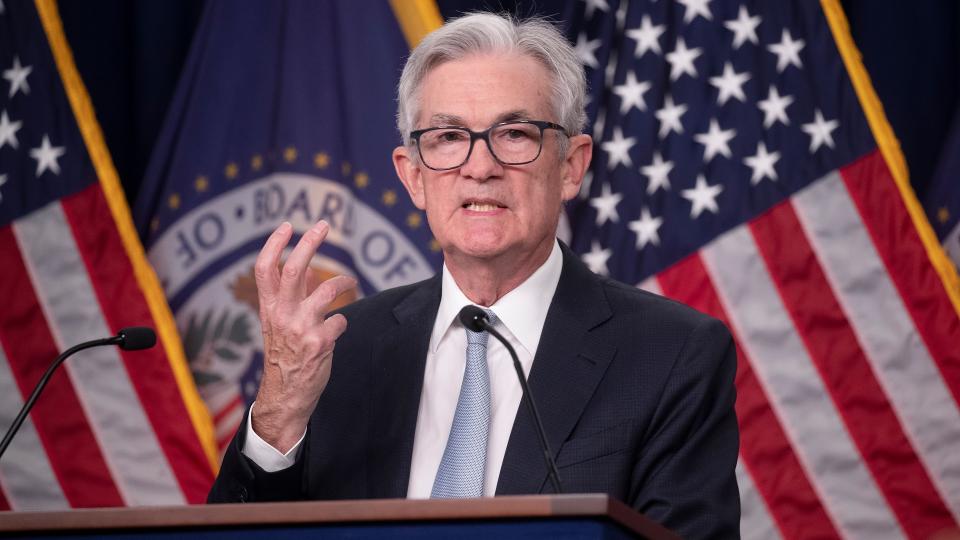Why Does the Fed Keep Increasing Interest Rates? 3 Expert Tips to Ride It Out

On Nov. 2, the Federal Reserve once again raised interest rates, the sixth straight increase this year — and the fourth 75 basis point hike in a row since June.
See: Jaw-Dropping Stats About the State of Retirement in America
Find: What Is the Highest Income Level for Food Stamps in 2023?
The targeted rate for interest on federal funds is now 3.75% to 4%, per CNN, the highest it’s been since 2008 when the housing crisis weighed heavy on the American economy and forced the country into a recession. CNN also reported the 2022 actions come as the “Fed’s toughest policy moves since the 1980s,” affecting everything from mortgages to car loans to credit cards.
As GOBankingRates previously reported, analysts believe we will soon “blow past” the all-time-high credit card interest rate of 19% that was set in 1991. “Most credit card holders should see the Fed rate hike passed through to their rate within a statement cycle or two,” said Ted Rossman, senior industry analyst at Creditcards.com.
Why The Fed Keeps Raising Interest Rates
Given how much hardship this places on the American people — already struggling with economic woes waged by the pandemic and now with 40-year-high inflation rates — why does the Fed keep increasing interest rates?
Put simply, the Fed has explained they are trying to curb that very inflation affecting people’s pocketbooks. According to the latest Consumer Price Index data, Americans are currently paying 8.2% more across all categories as compared to this time last year, including a 58.1% jump in fuel prices and a 13% increase in the cost of groceries.
“If we don’t get inflation under control… now we’re in a situation where inflation is now entrenched and the employment costs, in particular, will be much higher potentially,” Fed chair Jerome Powell told reporters during a Nov. 2 press conference, per CBS, rationalizing the Fed’s decision and also alluding to the fact that this may not be the last interest rate hike we will see. Powell added, “It is very premature to be thinking about pausing.”
Experts Weigh in on Fed Hikes, Broader Economy
Chris Miles, cash flow expert and CEO of financial advice firm Money Ripples, has another opinion. When it comes to why the Fed keeps raising rates, he believes it’s not as much about controlling inflation, but, “Ultimately, their No. 1 job is to protect the value of the U.S. dollar,” he says. “You may have noticed that the U.S. dollar is strong across the world. That’s because we were the first to begin raising rates, and that has attracted money from other countries to invest in our dollar… the Fed wants to be sure that our dollar is more valuable than any other currency right now.”
In his opinion, Miles believes that the Fed will continue to raise rates more than even initially predicted. “In the September Fed meeting, [Chair] Powell inferred that he will support raising rates until the Fed rate exceeds the CPI. As of now, the CPI is still 8.2%. They just raised the Fed rate to 4%,” says Miles, adding, “Until this week, many experts believed it would hit about 4.6%. Now, they’re estimating around 4.8%.” As far as his prediction goes, Miles believes “the rate will go up to 5.5% to 6% before they begin settling as inflation begins slowing down.”
However, Miles does believe the recent moves by the Fed will eventually slow down inflation, “as long as they slow down the credit supply.” Miles says one of two things have to happen to accomplish this. “Either they have banks become very restrictive on the loan approvals, like in 2008-2009. Or they raise interest rates to the point that less people apply for credit.”
As he adds, economies are based around credit availability. “The more money available, the faster money can move. Ironically, it was the Fed’s decision, along with political pressure, that caused them to make unprecedented amounts of cash available, causing inflation to go out of control. They’re now swinging the pendulum the other direction to slow it back down.”
Tips for Dealing With Increased Interest Rates
Miles notes these moves are now negatively impacting the poor and middle class the most and messing with most peoples’ retirement accounts as stocks plummet. So, what can the average American do to get by and be proactive as interest rates keep skyrocketing? Miles has some tips:
Pay off variable interest loans. “The best thing consumers can do right now is pay off their variable interest loans, like credit cards. Don’t focus so much on paying off the lower fixed rate loans, like mortgages, cars, student loans, etc. Focus on eliminating all variable rate loans, and build up your cash reserves.”
Focus on having cash on hand. “Cash may sound counterintuitive, but I believe cash is going to become a very valuable commodity as more people’s savings dwindle, and future layoffs are very possible.”
Take Our Poll: How Long Do You Think It Will Take You To Pay Off Your Credit Card Debt?
More: States Whose Economies Are Failing vs. States Whose Economies Are Thriving
Invest in property — if you can. “For those that don’t have much debt and have a lot of cash, I would focus on owning real property, like profitable rental real estate, especially in certain markets, like the Midwest or Southeast. Avoid hot markets like Phoenix, Florida, Texas, Las Vegas, or anything in the western U.S. Those prices are already coming down. But even in those markets, as prices settle and sellers are becoming more desperate, it’s starting to become a buyers market again.”
More From GOBankingRates
This article originally appeared on GOBankingRates.com: Why Does the Fed Keep Increasing Interest Rates? 3 Expert Tips to Ride It Out

 Yahoo Finance
Yahoo Finance 